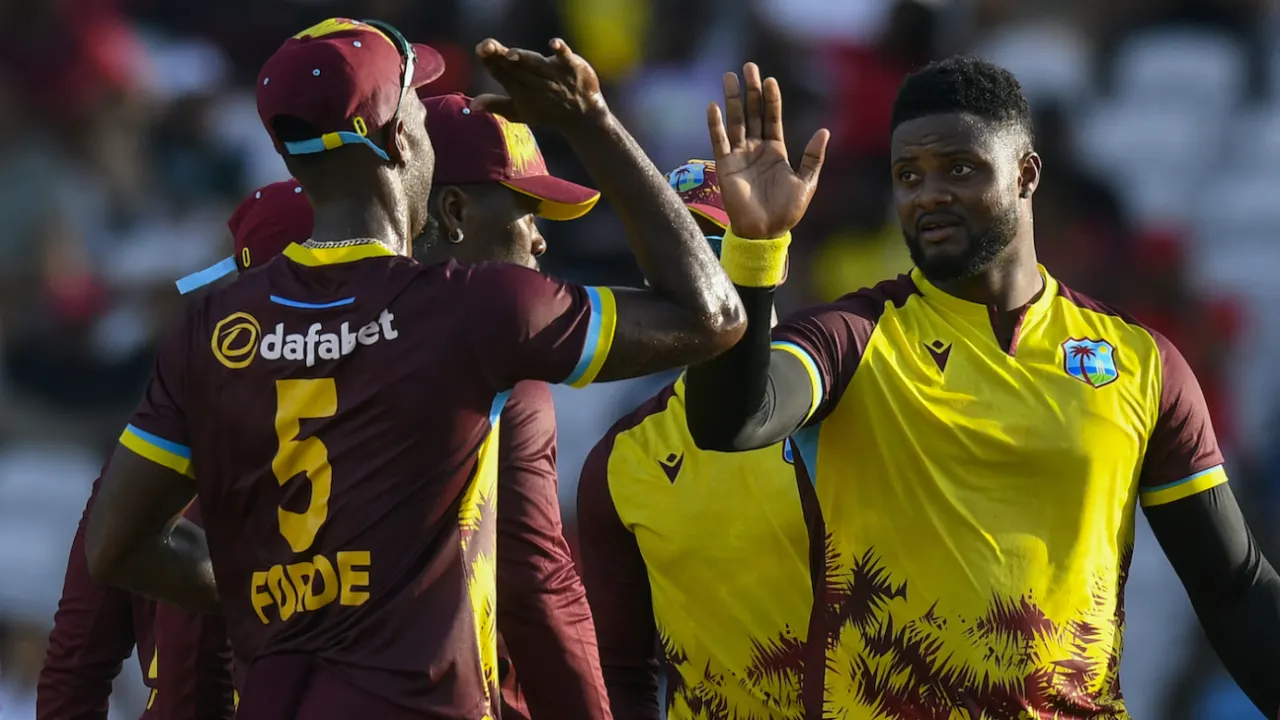The West Indies claimed their third consecutive T20I series victory over South Africa with a dramatic 30-run win, defending a total of 179 at the Brian Lara Cricket Academy. The match saw South Africa falter after a strong start, as they lost seven wickets for just 20 runs in 36 balls, ultimately being bowled out for 149 in 19.4 overs. This win solidified the West Indies’ growing dominance in the shorter format, while South Africa was left to ponder over a middle-order collapse that cost them the series.
A Promising Start Turns Sour for South Africa
South Africa’s chase began with great promise. They raced to 129 for 3 in the 14th over, looking well on course to level the series. Reeza Hendricks, in particular, was in sublime form, scoring 44 runs off 22 balls with some exquisite stroke play. Hendricks had set the tone early on, ensuring that South Africa reached 71 in the powerplay, and even after his dismissal, the Proteas appeared to be in control.
However, the game turned on its head as South Africa lost 7 wickets for just 20 runs in a span of 36 balls. What seemed like a straightforward chase quickly spiraled into chaos, and the West Indies seized the opportunity with both hands. South Africa’s middle and lower order crumbled under pressure, with only one batter after No. 3 managing to score more than 20 runs. The dramatic collapse highlighted a major area of concern for South Africa, who had struggled to maintain momentum and composure after the initial onslaught.
Akeal Hosein and Gudakesh Motie Spark the Collapse
The turning point in the match came when the West Indian spinners, Akeal Hosein and Gudakesh Motie, stepped up to dismantle South Africa’s middle order. Hosein, after conceding 17 runs in his first two overs, returned in the 14th over to deliver a crucial breakthrough. With South Africa cruising at 125 for 3, Hosein deceived Tristan Stubbs with a slow, flighted delivery that the batter failed to clear over long-off. The substitute fielder Fabian Allen took a comfortable catch, and the West Indies sensed blood.
Motie followed suit in the next over, removing Donovan Ferreira with another piece of clever spin bowling. Ferreira was stumped, leaving South Africa reeling at 136 for 5. The momentum had shifted decisively in favor of the West Indies, and from that point on, the South African batters found it difficult to recover. Hosein delivered the final blow to South Africa’s hopes when Rassie van der Dussen, who had been anchoring the innings, was caught at midwicket after mistiming a shot. South Africa was now 138 for 6, with 42 runs required off 24 balls – a daunting task against the disciplined West Indian attack.
Romario Shepherd and Shamar Joseph Seal the Deal
With the momentum firmly on their side, the West Indies’ pacers Romario Shepherd and Shamar Joseph took over the final phase of the game. Shepherd, in particular, was outstanding, finishing with figures of 3 for 15 in his four overs. His ability to maintain tight lines and vary his pace proved too much for the South African lower order, who struggled to get him away.
Joseph, too, delivered a career-best performance, taking 3 for 31, including the crucial wicket of Van der Dussen. Between them, Shepherd and Joseph extinguished any lingering hopes South Africa had of pulling off a miraculous chase. They combined to mop up the tail, ensuring that South Africa’s innings ended at 149, well short of the target.
West Indies’ Big-Hitting Prowess
One of the key differences between the two sides in this match was the West Indies’ superior power-hitting. While South Africa managed just six sixes in their innings, the West Indies cleared the ropes 13 times, demonstrating their ability to capitalize on scoring opportunities. Shai Hope, Rovman Powell, and Sherfane Rutherford were among the standout performers with the bat for the West Indies, contributing to a competitive total of 179 for 6.
Hope, who had played a match-winning role in the first T20I with a half-century, continued his fine form with 41 runs off 24 balls. His innings was characterized by his powerful leg-side hitting, as he struck four sixes, all of which came on the leg side. Powell and Rutherford provided the finishing touches, adding 47 off 28 balls for the fifth wicket, ensuring that the West Indies had enough runs on the board to put South Africa under pressure.
Patrick Kruger’s Double Strike Keeps West Indies in Check
Despite their eventual success, the West Indies’ innings wasn’t without its challenges. Patrick Kruger, playing in only his second T20I, made an impact with the ball, taking two crucial wickets in the middle overs. Kruger dismissed the well-set Hope for 41, enticing him into a wide delivery that was caught at deep point. He then struck again in the same spell, removing Roston Chase for a duck with another wide delivery that was caught on the boundary.
Kruger’s double strike threatened to derail the West Indies’ innings, but their ability to accelerate in the final overs ensured that they posted a challenging total. The 50 runs scored in the last five overs by Powell and Rutherford were crucial in shifting the momentum back in favor of the West Indies.
Shai Hope’s Leg-Side Domination
Shai Hope has emerged as one of the West Indies’ most reliable performers in the T20I format, and his innings in this match showcased his ability to dominate on the leg side. Hope’s preference for playing on the leg side was evident, as he scored 39 of his 41 runs on that side of the wicket. His power and precision when pulling and flicking the ball made it difficult for South Africa to contain him.
Hope’s innings was a perfect example of how a player can utilize their strengths to maximize scoring opportunities. His ability to hit with the turn and take advantage of the wind in Port of Spain allowed him to clear the boundary with ease. Though he missed out on another half-century, his contribution was vital in setting up the West Indies’ total.
South Africa’s Middle-Order Woes
South Africa’s defeat highlighted their ongoing struggles with middle-order stability. Despite a strong start, with Hendricks and Stubbs leading the way, the rest of the batting lineup failed to make meaningful contributions. The inability to rotate strike and the lack of composure under pressure were evident as South Africa’s middle-order batters fell into the West Indies’ spin trap.
The absence of a stabilizing presence in the middle overs left South Africa vulnerable to collapse, and their inability to chase down 180 despite being in a strong position will be a major concern heading into future T20I matches. The Proteas will need to address their middle-order issues and find ways to close out games if they are to compete at the highest level in the format.
West Indies’ Tactical Brilliance Outshines South Africa
The West Indies’ victory was a result of tactical brilliance, effective use of spin, and disciplined death bowling. Their ability to stay calm under pressure and force South Africa into making mistakes ultimately won them the match and the series. South Africa, on the other hand, will have to reflect on their inability to finish games after promising starts. Their middle-order frailty and lack of big-hitting options in the latter stages of the chase were exposed once again.
As the West Indies continue to build towards major tournaments, their success in defending totals and their growing confidence as a unit make them a formidable force in T20I cricket. South Africa will need to regroup and address their vulnerabilities if they are to challenge the world’s best in the shortest format. This series serves as a reminder of the fine margins that define success in T20 cricket and the importance of seizing critical moments in the game.
Please check for information on the best betting sites in India – https://selectory.org/best-betting-sites/















